Hieronymus Bosch (Jeroen Anthoniszoon van Aken; s’ Hertogenbosch, 1453 - 1516) was a Dutch painter active in the late fifteenth and early sixteenth centuries. His experience can be framed within the framework of Flemish painting: until the independence of the Northern Netherlands in the late sixteenth century, in fact, Flanders andDutch painting had a common history. Flemish painting experienced a remarkable development after the capital of the duchy of Burgundy was moved to Bruges, in Flanders, in 1419: the event brought to the region a cosmopolitan wealthy bourgeois class, attentive to and interested in works of art.Toward the middle of the century, trade with Italy also intensified, and the primacy of Bruges passed to the city of Antwerp, increasing commissions and encouraging the movement of artists. Italian painters turn out to be increasingly interested in learning about the works of the Flemish; many, in fact, create the conditions to see the works themselves. Art historians speculate about direct contact between the Tuscan artist Piero della Francesca (Borgo San Sepolcro, 1412 - 1492) and the Flemish Rogier van der Weyden (Tournai, 1399 - 1464, Brussels), who traveled among Italian courts in the mid-15th century. It is also certain that Italian painters saw the works of the famous Van Eyck or other Flemish artists in Florence and Genoa, two culturally and economically prosperous cities. Flemish painting was also influenced by the great Italian artists, thus allowing a system of mutual influences to take place. The mutual influences do not end with a specific date, but in the seventeenth century there is a loss of interest, with less influence of Italian art on Flemish art and vice versa.
Of interest is the position of the city of Genoa, a mercantile and commercial power, which throughout the 15th century occupied a crucial position in the spread of Flemish painting in Italy. The Ligurian aristocracy greatly appreciated the works of artists from Belgium and Holland: thus an assiduous and intense collecting was established. Economic exchanges fostered a fruitful proliferation of works, which today flow into various collections, for example that of Palazzo Bianco, and into numerous Genoese picture galleries. Even today there are coats of arms of the city of Genoa in Bruges, in the palace of the consulate, but also in Antwerp, where the phenomenon of penetration of Italian Renaissance taste is grafted onto a painting of late Gothic taste. There are two artists in whom the phenomenon of union between Renaissance art and late medieval painting is present, Cornelis Engebrechtszoon (Leiden, 1462 - 1527) and Jacob van Oostsanen (Oostzaan, 1470 - 1533, Amsterdam).
Then there is an artist who works independently, with quite different intentions, drawing on vivid imagery, without referring to the themes of classical antiquity like the painters active in his own years: this is Hieronymus Bosch himself, whose works represent a perfect combination of local traditions and personal inventiveness.
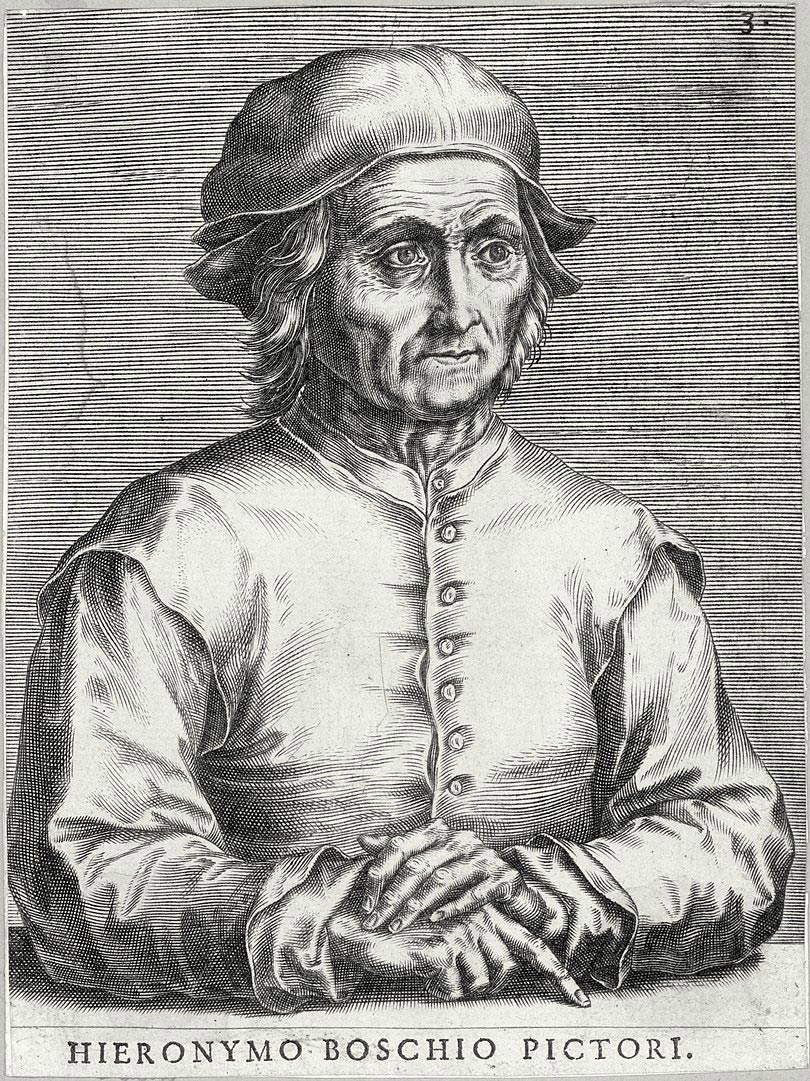 |
| Cornelis Cort, Portrait of Hieronymus Bosch (c. 1550) |
The uncertain biography of Hieronymus Bosch
Biographical information about the artist and its dating is poor, as is information about the period of his training. Jeroen Anthoniszoon van Aken, later Hieronymus Bosch, was born in Holland in ’s Hertogenbosch on October 2, 1453, to a family of painters. Known in Spain by the nickname El Bosco, or Jerome Bosco, still Bosco di Bolduc, and in Italy as Ieronimo Bos. It is speculated that as a young man he made trips to Antwerp or Brussels, but we do not know in what years exactly. In about 1480, or perhaps earlier, he married AleytdeMeervenne, the daughter of a wealthy family; this allowed the artist to practice painting freely and without worry, not having to think about debts or financial defaults, common problems for an artist of the time.
At a date sometime between 1486 and 1488, he joined the Confraternity of Our Beloved Lady in his hometown, which was linked to the cult of the Virgin and in whose archives is the little information we have about the artist’s life. Membership in this association offered the artist the opportunity to place his works within a European patronage , which enabled him to gain notoriety, entertain relations with the higher social classes, and, of course, procure a wealthy clientele. Moral principles, religious dogma, and the condemnation of sins are among the artist’s major themes, learned through the experience of the Brotherhood, in connection with the mystical movement Devotio Moderna, active in the Netherlands in the mid-15th century.
Bosch did not like to travel or be inspired by other artists, but he supposedly made two trips to Europe in his lifetime. The period between 1500 and 1510 is the most artistically fertile; it is during these years that the most important triptychs (works consisting of three painted panels, a larger central one and two side panels, smaller in size) that have come down to us, such as the famous Garden of Delights, are dated. Another important triptych, made between 1506 and 1508, is the Triptych of the Judgment, followed by the Triptych of the Adoration of the Magi from 1510. From the same year are the Triptych of the Passion and the Triptych of St. Anthony, a masterpiece of the artist’s maturity. One of the few documents in his biography records a major commission, by Philip the Fair, duke of Burgundy from 1482 to 1506, who in September 1504 commissioned him to paint a picture with the theme of the Last Judgment (we do not actually know exactly which work this is).
Bosch died, possibly as a result of a cholera epidemic documented in ’s Hertogenbosch itself, on August 9, 1516. The documents of the Brotherhood include a requiem dedicated to the loss of the artist Jeronimus van Aken painter, dating from August of that year, suggesting that it was indeed the disease that took the artist away at the age of just over sixty.
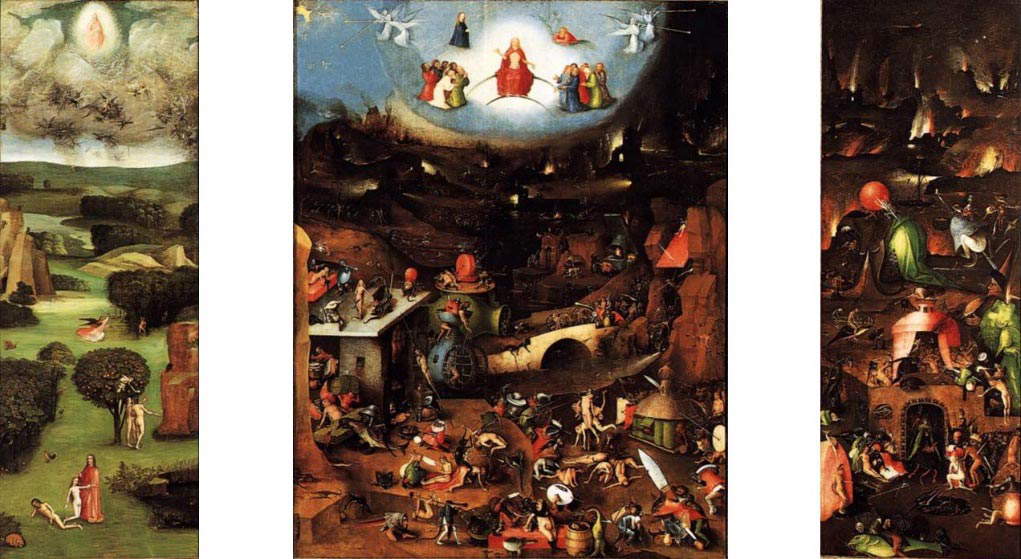 |
| Hieronymus Bosch, Triptych of the Judgment in Vienna (1482; oil on panel, 163.7 x 242 cm; Vienna, Academy of Fine Arts) |
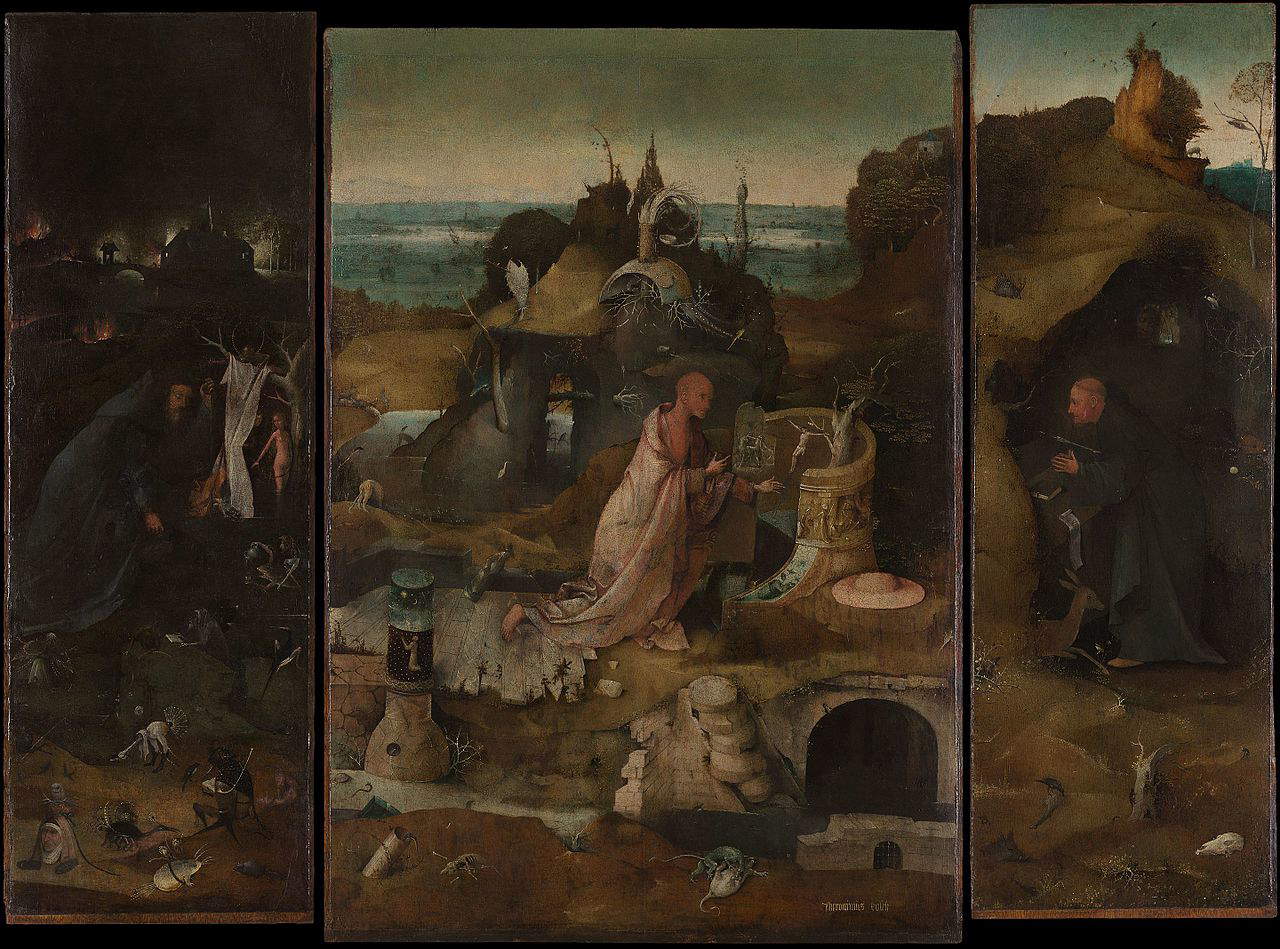 |
| Hieronymus Bosch, Triptych of the Hermits (c. 1493; oil on panel, 86.5 x 120 cm; Venice, Gallerie dell’Accademia) |
Evolution of Bosch’s style: from youth to maturity
Bosch’s life can be reconstructed through his paintings, although even here there are chronological lapses. The artist’s works, as mentioned earlier, were highly regarded by the art market of the time, but continued to be so after his death. His esteem in the centuries to come was so high that contemporary critics considered him a source of inspiration for some of the most important artistic currents of the late 19th century, such as Symbolism, and laterGerman Expressionism and the Surrealist movement, which arose in the early 20th century. Considerable influence also had on Freudian theories, which tended toward the discovery of the unconscious, an inner dimension that is invisible but present in each of us. The influence on the aforementioned artistic movements is largely due to his choice of themes: Bosch, in fact, draws on a dimension that is continually nourished by symbols, coming from the medieval tradition, but also from 15th-century miniatures and satires. The choice of themes is due to the artist’s attitude of condemnation of sins, from his contempt for corruption and those vices that make man a sinner.
Works attributed to the early period include The Cure of Mad ness where the extraction of a stone from the brain of a madman is depicted, the FrankfurtEcce Homo, the Crucifixion in Brussels, the Juggler, and the Seven Deadly Sins. In the latter, seven scenes are depicted separated from each other by circles, at the center of which is the eye of God, intent on “fixing our deeds on earth.” While at this early stage of his artistic career his style consists of pure color combinations and soft brushwork, in his maturity he also added an interest in detail, through the meticulous definition of details, producing increasingly crowded compositions, without neglecting precision in painting rich landscapes.
Opening the artist’s maturity is the triptych with the Temptations of St. Anthony, a work of which between fifteen and twenty copies exist today, testifying to the artist’s appreciation. In the central panel is Saint Anthony, kneeling before the crucifix, unaware of what is happening around him; the devil tries to make the saint fall into sin, without success. At the center of the work is an interest in the human theme of temptation. Laterally, finally, is depicted hell and what happens to those who end up there, namely sinners. Although the characters seem to belong to a fantastic dimension, in reality each of them refers to a specific concept. For example, in the work that represents the pinnacle of his career, the Garden of Earthly Delights, the acrobats allude to men who seek to alter the laws that govern nature. The painting is a movable triptych, that is, composed of three panels that can be folded back on themselves. The closed triptych represents The Creation of the World, through a round, perfect sphere floating in the void. The work, in its frontal view, depicts three scenes: from the left, the Garden of Eden, the Garden of Delights, and Musical Hell. In the first panel, at the bottom left, there is a trio, consisting of God, Adam and Eve; their expressions are ambiguous, one cannot understand what they are thinking or doing. The mysteriousness of the work continues in the choice to depict strawberries and cherries compulsively, in the central panel. Perhaps the artist wanted to represent the garden of worldly delights, far from a religious interpretation, linked only to the trio of creation? Or did the central panel represent earthly reality, far removed from celestial reality?
Bosch is still being investigated and studied today, for several reasons: the complicated and mysterious symbolism that shines through his works, the halo of mystery that envelops certain of his creations as well as his own life, his imagination that leads him to populate his paintings with fantastical characters that have few other parallels in the history of art and that fascinate the public greatly today, the invention of themes and characters, steeped in symbols, visions and hallucinations.
 |
| Hieronymus Bosch, Seven Deadly Sins (c. 1500-1525; oil on panel, 120 x 150 cm; Madrid, Museo del Prado) |
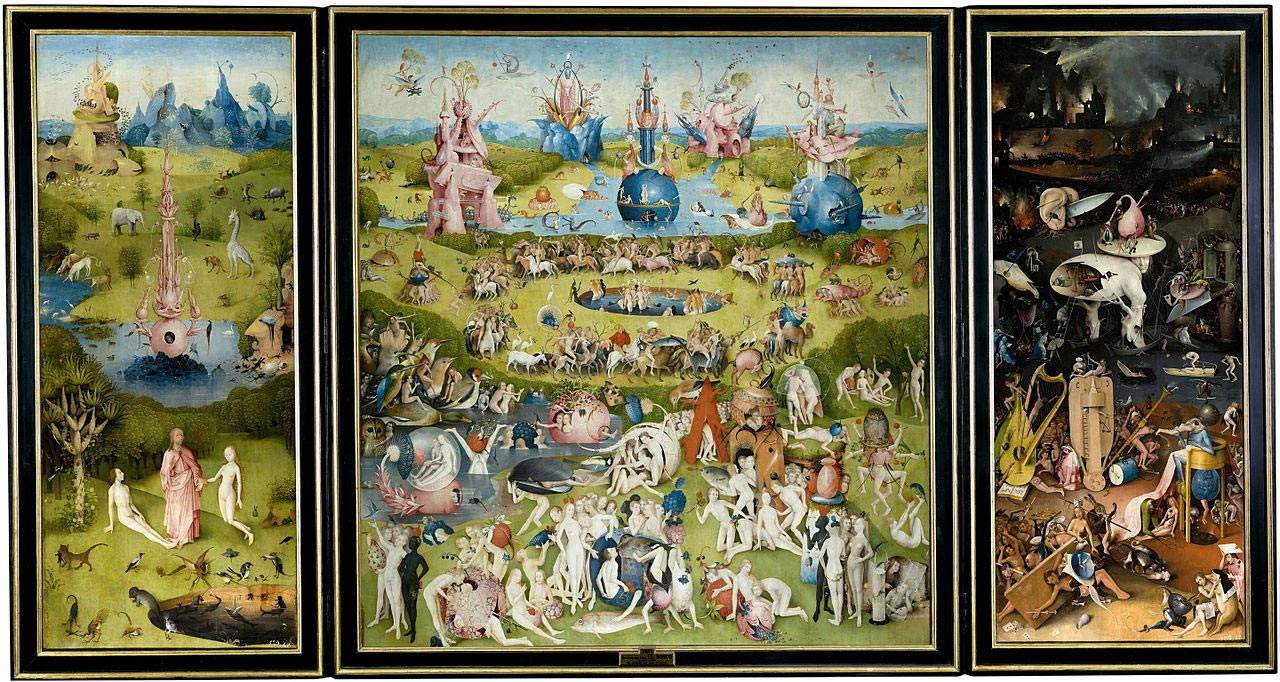 |
| Hieronymus Bosch, Garden of Delights (c. 1480-1490; oil on panel, 220 x 389 cm; Madrid, Museo del Prado) |
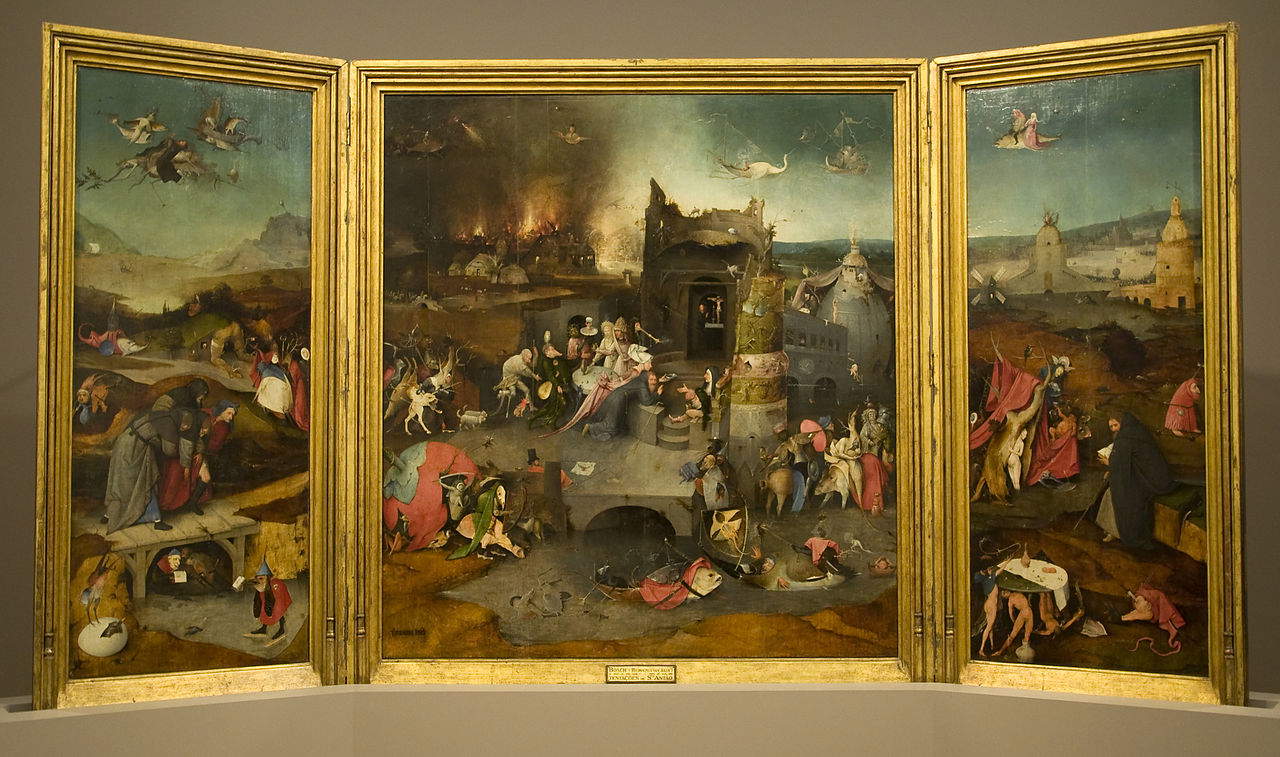 |
| Hieronymus Bosch, Triptych of the Temptations of St. Anthony (1501; oil on panel, 131 x 238 cm; Lisbon, Museo nazionale darte antica) |
Where to see Bosch’s works in Italy and Europe
There are very few works by Bosch that we know of. In Italy there are just three works by the Dutch painter, all housed in the Gallerie dell’Accademia in Venice, where masterpieces by 16th- and 17th-century Italian painters active in the Veneto region, such as Tintoretto, Titian, Canaletto, Giorgione, Giovanni Bellini and Veronese, are preserved: these are the Triptych of the Crucified Martyr, the Four Visions of the Afterlife (a work consisting of four panels, the horizontal reading of which takes the viewer from the Ascent, Paradise, to the Fall of the Damned, Hell) and the Triptych of the Hermits.
In order to see his masterpieces, it is also advisable to go abroad, particularly to the artist’s hometown, where there is the Jheronimus Bosch Art Center, dedicated to his life and works. Curiously, however, this museum does not preserve any of his works. Bosch’s only autograph paintings on Dutch soil are all in the Museum Boijmans van Beuningen in Rotterdam and are the Peddler, St. Christopher , and the Flood Tables. The triptych with the Temptations of St. Anthony is kept at the National Museum of Ancient Art in Lisbon, the most important museum in Portugal, founded in 1884 and housing ancient works up to the 19th century.
At the Museo del Prado in Madrid (in Spain, Bosch is known as “El Bosco”) are some of his important juveniles: the Seven Deadly Vices, the Cure of Madness, and the Hay Chariot. Perhaps his best-known masterpiece, the Garden of Delights, his most ambitious achievement, is also kept here. The museum, built in 1785 and designed by architect Giovanni de Villanueva but not opened until 1819, houses among the masterpieces of 17th-century Spain, works by El Greco, Giuseppe de Ribera, and Diego Velasquez, as well as artists active in the second half of the 18th century, such as Francisco Goya. One of his last works, from about 1510, can be seen at the National Gallery in London: it is Christ Mocked. Still, a youthful Ecce homo can be seen in Frankfurt am Main, in Ghent, Flanders, the Ascent to Calvary and St. Jerome at Prayer are preserved at the Museum voor Schone Kunsten, and also in Belgium, but at the Musées Royaux des Beaux-Arts de Belgique, is the Crucifixion with Donor.
 |
| Hieronymus Bosch, mystery painter: life and works |
Warning: the translation into English of the original Italian article was created using automatic tools. We undertake to review all articles, but we do not guarantee the total absence of inaccuracies in the translation due to the program. You can find the original by clicking on the ITA button. If you find any mistake,please contact us.